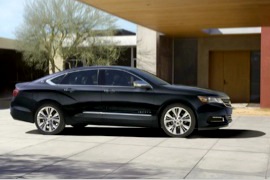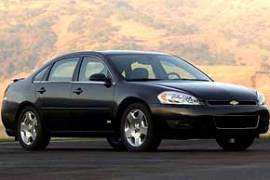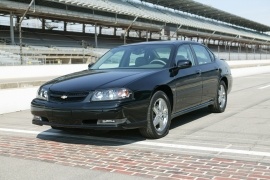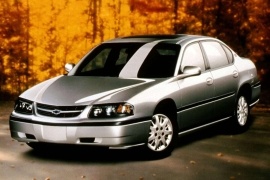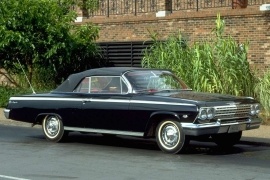CHEVROLET Impala Models/Series Timeline, Specifications & Photos
First production year: 1966
Engines: Hybrid gasoline, Gasoline, Natural gas
Chevrolet introduced the tenth generation of the Impala in 2013 as a 2014 model-year on the same platform as the Cadillac XTS and the Buick LaCrosse.
After parting with Opel and Saab, GM kept the Epsilon II platform in both versions with a short or long wheelbase. It was designed in Germany for front-wheel-drive vehicles and adapted in Sweden to support all-wheel-drive ones. Its most extended form complied with GM demands for a pre-premium car.
Chevrolet insisted on a fastback-like bodywork, similar to the one from the Opel/Vauxhall Insignia. Its sculptured side panels and the arched line over the rear wheels emphasized a sport-sedan image since it played in the big-car league against Honda Accord or Toyota Camry. Its headlights came fitted as standard with HID lamps and LED daytime running lights for selected trim levels.
Inside, the design team benefited from the long wheelbase and installed thick bucket seats at the front and a comfortable bench profiled for two full-grown adults in the back. The tall center tunnel made life difficult for a third passenger, and the carmaker didn't even bother to install a third headrest. While the base trim-levels sported cloth seats, on the upper versions, the interior was leather-wrapped.
Under the hood, Chevrolet offered the Impala with a choice of four engines, including a hybrid version. The carmaker offered the car with a standard six-speed automatic transmission for the entire range.
Chevrolet introduced the ninth generation of the Impala at the 2005 Los Angeles Auto Show for the 2006 model year, continuing the line of one of the most successful nameplates in the carmaker’s inventory.
The Impala was an essential vehicle in GM’s inventory since it was the base model for many fleets, being a preferred vehicle for car rental services. As a result, the automaker hoped for high sales volumes, and its expectations were confirmed. In 2007, the car sold more than 300,000 units, and even in the worst years of the world financial crisis, those numbers didn’t drop below 160,000 vehicles, helping the automaker stay afloat. In addition, the contracts with law-enforcement agencies were also essential for Chevrolet, and the Impala was among the cars that entered those fleets.
The Impala boasted a front fascia with a low nose and a thin horizontal grille where the bow-tie badge took center stage. The organic-shaped headlights were swept back towards the fenders and sported inner and outer amber lights for the turn signals. Chevrolet added a bumper that featured an additional cooling area on the apron and flanked it with side scoops that housed the fog lamps, which were offered as an option. Still, despite being primarily a fleet vehicle, the automaker offered it in four grades: LS, LT, LTZ, and SS, respectively.
From its profile, the Impala boasted a sleek look with an ascending waistline and chromed surroundings for the windows area. Behind the sloped-down rear window, the automaker placed a tall, short deck that could be adorned by a small wing. The Impala came standard with 16” steel wheels, while 16- or 17-inch alloys were available, depending on the trim level. Furthermore, the body-colored door handles and mirrors gave the car an elegant look. At the back, the corner-mounted taillights had a triangular shape with a clear lens area on their lower side to match the chromed stripe that crossed the trunk lid. Underneath the bumper, the automaker installed side exhausts for a sportier look, even though the car was mostly a family or fleet-friendly mid-size sedan.
Inside, Chevrolet took advantage of the 110.5-inch (2,807 mm) wheelbase and the front-wheel drive system to create a spacious cabin where up to six people could comfortably fit. At the front, customers could get either two bucket seats or a bench seat. In the former version, the car had a steering-column mounted gear selector, while for the latter, a floor-mounted one was available. The driver fronted an LED-lit instrument cluster with a clean design and just four dials to check. In addition, an LCD was at the bottom of the panel and showed the odometer and other data gathered from the onboard computer. In the back, there was plenty of room for three adults, with enough legroom and headroom.
Under the hood, Chevrolet installed a choice of three engines: two V6s and one pushrod V8 that featured cylinder deactivation, a first for the brand. All sent their power to the front wheels via a four-speed automatic. The top trim level, the SS, featured stiffer suspension and larger stabilizer bars.
We’re sure you’re familiar with the Impala nameplate and the 60’s Impala’s muscular lines come to your mind. Many say that the 2004 Impala was just a marketing strategy, but was it?
Well… the new Impala was definitely fast. As fast as the 90s’ Impala. Driven by a 3.8-liter pusher V6 engine that developed 240 hp and 280 lb.-ft of torque, mated with a Hydra-Matic 4T65-E 4-speed automatic transmission, the sedan was great for touring, providing smooth shifts and a quick kick-down reaction.
However, the power was sent to the front wheels, while the Impala used to suggest a rear-wheel-drive only vehicle.
Aesthetically, the 2004 Impala could easily get lost in the crowd, with a rather dull exterior design. The sedan was only available in a monochromatic black exterior and featured a rear spoiler, side folding and 17-inch alloys.
Inside, everything was well laid out with all controls easily deciphered and easy to use. The generous panel of instrument included both boost and oil temperature.
Space-wise, the Impala was very roomy with a bench installed in the rear cabin. The passengers enjoyed great headroom and legroom.
The trunk was a good size as well, offering 526 liters of storage.
Standard features coming with the Impala were power windows, door locks and mirrors.
Chevrolet re-introduced the Impala nameplate in 1999 after it took it off the market in 1996 and built it on an entirely new platform.
The eighth generation of the Impala showed the most significant change in the model's history since it was no longer a rear-wheel drive vehicle, switching the car to the W Platform shared with the Monte Carlo, the Buick Regal, and the Pontiac Grand Prix. All of these were front-wheel driven, and the Impala also benefited from this change.
It came on the market to replace the Lumina lineup and sported a new design with curved lines and, somehow, a domestic appearance. Its two-headlamps design for the headlights resembled the older models built in the '60s. The broad grille sported a V-shaped slat that incorporated the bow-tie badge in the middle. Moreover, depending on the trim level, it showed a more aerodynamic package. Impala's profile revealed a cab-rearward design, enhanced by a third window behind the rear doors, like on its predecessor. Last but not least, the back showed a big red cover where the two-headlamps design resembled the front fascia.
Inside, thanks to the transverse-engine layout, the carmaker could offer more room. Even though it was in the mid-size segment vehicle, the interior room qualified it for the large-car category. There were just two trim levels, with the base version featuring cloth upholstery, while the upper trim level got leather seats.
Under the hood, Chevrolet installed a choice of two engines: a 3.4- and a 3.8-liter, both mated to a four-speed automatic transmission.
Chevrolet introduced the fourth generation of the Impala in 1965, in the middle of the muscle-car era, and prepared a Super Sport version for it, which came a year later.
With all the pony-cars and sports cars, and muscle cars around, it was hard for a carmaker to launch a new coupe on the market. Yet, Chevrolet dared to offer the Impala with a Super Sport package, and it was close to competing with its own Chevelle or Malibu, both being offered with a Super Sport package. But the Impala was more of a personal coupe than a muscle car.
While its four-door sedan broke all the sales records and passed the one-million cars sold in twelve months, the Impala Super Sport was the kind of vehicle sold for those who couldn't go to the drag-strip, but they wanted to. It was large, with two doors and with room for six. Moreover, in the open-top version, it looked even better. Its chromed grille at the front and dual headlights system looked impressive but not intimidating.
Inside, the SS model was available with a wood-trimmed steering wheel, a heating and air-conditioning unit, and a radio. Its bucket seats at the front were too flat to be called that way, but that's how Chevrolet named them on the options list. The carmaker provided a tilt and telescopic steering wheel, but only depending on the trim level and options.
The Super Sport version featured a four-speed manual transmission with an option for a two-speed automatic. Later on, Chevrolet introduced a three-speed automatic for the Super Sport. Under the hood, the carmaker installed a seven-liter V-8 engine that produced 390 hp. That was enough for a muscle car, but the Impala, with its almost 4,000 lbs (1,800 kg) weight, was too heavy. Not to mention that it wasn't available with disc brakes.
